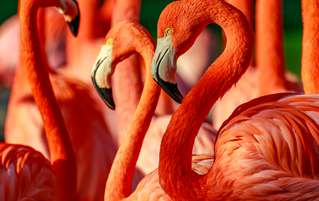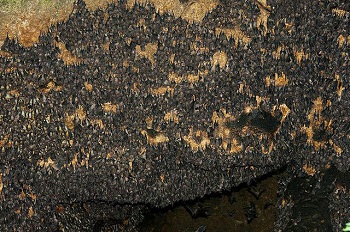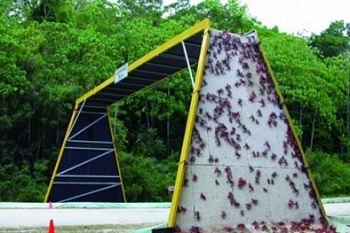6 Massive Animal Swarms That Are Impressive And Horrifying

We humans tend to think that we successfully conquered the planet centuries ago and are currently sitting comfortably at the top of the food chain. But there are several different species of animals, including bats, crabs, and walruses, that routinely travel in groups so hopelessly massive that it really does appear they could easily knock us off that throne like a jousting match on American Gladiators. They just choose not to. Yet.
Giant Fruit Bats Live And Fly In Swarms Of Millions

Samal, Philippines, is a lovely place. The "Island Garden City" is a honeymooner's paradise, complete with breathtaking natural landscapes, scenic beaches, beautiful resorts, and a giant bat-filled hole in the ground.

Rich orphans get free admission.
And we don't mean that pit is teeming with sporting equipment. It is a scar in the Earth loaded with winged night-mice:

And the terrified thoughts of everyone in a 20-mile radius.
Monfort Bat Cave is home to the largest colony of bats in the world, and they aren't the teeny-tiny kind, either. These are Geoffroy's rousettes, scientifically classified as fucking megabats. Rousettes are fruit bats, which means they don't drink blood (at least, not with any witnesses around), but the fact that there are between 1.8 million and 2.3 million of them is enough to make even the underdwellingest mutant uncomfortable.

Only half the poop you see left behind is guano.
The farmers of the surrounding areas aren't particularly fond of the cave -- which is a conservation area -- but that doesn't worry the owner of the property, who is actually planning to build additional bat caves to deal with the current overcrowding issues. It's so full that some of the bats have to sleep on the ground outside the cave, which in turn attracts hordes of predatory snakes and rats, which means nobody within five miles of that goddamn cave is going to get any sleep.
Have you ever wondered whether a multi-million-member flock of bats taking flight looks like the end of days? Well, you're in luck, because here is a picture of one of those things:

So, yes.
That's Kasanka, Zambia, where an estimated 10 million to 15 million fruit bats migrate from late October to December, stripping bare more than a billion fruit trees as they pass. These guys don't have a sweet cave to sleep in during their migration, so they just land on trees, bushes, and really any surface that happens to be available to them. This unholy bat-blizzard is the largest mammalian migration in the world, easily outperforming the second-largest mammalian migration -- of the wildebeest in the Masai Mara -- and looking a thousand times more metal in the process.

Hell Bent For Leather Wings
Crabs Occasionally Form Giant, Horrible Armies (On Land And Underwater)

Crabs are maybe one socio-evolutionary rung above cockroaches in terms of species that are respected by the animal kingdom, so it probably seems strange that anyone would actually close a major thoroughfare to facilitate a widespread crab migration, instead of just running the damn things over.

To be fair, melted butter probably can't mask the taste of tire residue.
Christmas Island is a tiny, 52-square-mile island in the Indian Ocean that is taken over once a year between October and December by tens of millions of red crabs, who are all meeting for their annual crab sex party. And therein lies the answer to why they simply don't run the crabs over -- 10 million crabs would immediately flip any consumer vehicle and punish the driver accordingly.

"And a pinch to cut a bitch!"
Every year for several weeks, Christmas Island locals have no choice but to endure the horror movie that is the red crab migration. Over 7.5 miles of crab fences have to be installed along roads, and special underground crab crossings and bridges have to be created to help the sex-driven crabs march across the island.

No shame in this walk.
At this point, it probably does not even need mentioning that Christmas Island belongs to Australia, the official sponsor of the world's most terrifying multi-legged creatures. Even Australia's Ministry of Environment describes the event like the plot synopsis of a SyFy Channel original movie:

"Coming this summer, it's Orgynado."
And a complete siege of an island isn't even the worst thing crabs have to offer, migration-wise. They also have a vast, undead, undersea army at their disposal. We've previously spoken about the giant spider crab, an animal that owns the rare distinction of being exactly what it sounds like. Every year, these giant critters swarm underwater by the thousands, which is probably a warning of some kind that humanity has thus far failed to decode.

"Yes, human. Make more shark movies. Ignore us. Gooooood."
Their mission is to molt: They flip over on their backs and lie perfectly immobile for hours, before finally emerging from their older exoskeletons with a fresh, moist orange shell. And before you ask, yes, the entire battalion of crabs emerges from their shells simultaneously, because the god of this universe is Chaos, and he is forever laughing at us all. And when they do, it seems as if the number of terror-crabs has doubled, because you now have the crabs as well as their shod exoskeletons lying in gigantic pile of nightmare fuel:

"Braaaiiiinnnsss!"
Locust Swarms Can Cross Oceans Thanks To Midair Cannibalism

Locust swarms are serious business: Sky-darkening insect masses that can tear through tens of thousands of tons of vegetation per day, impacting the food production of entire countries, are nothing to be taken lightly.

Which means you probably shouldn't walk around in them.
However, according to new studies, locust migration is actually way more of a horror show than we originally thought, which is saying something for an impossible cloud of starving insects.
Have you ever wondered why locusts form such large swarms? Is it strength in numbers or some kind of hive mind? Nope! The answer, in all likelihood, is rampant cannibalism.
Here's what the scientists are thinking: Locust swarms are ginormous flying masses of frenzied insects running from their peers to avoid being eaten, while simultaneously trying to eat the locust in front of them. You see, the normally herbivorous locusts develop a taste for each other sometimes, especially when they need some extra protein and salt, which we imagine happens a lot when you are a card-carrying member of a biblical plague.

"Sorry I have to do this, Mom, but God's Wrath ain't gonna feed itself."
With one locust chasing another and everyone releasing stress pheromones, things soon become a giant frenzy of panicked individuals fleeing from each other and trying to hunt each other down for a quick, violent meal at the same time (this is in addition to consuming everything else in their path). Basically, every locust swarm is just one giant daisy chain of cannibalism.
Another mystery about locust swarms is their ridiculous durability, as they have been known to cross actual oceans. For a long time, scientists were baffled by this, as the little insects cannot possibly have enough fat deposits to sustain them over such marathon distances. Well, cannibalism would explain this as well -- recent theories indicate that locusts may sustain themselves midair by making snacks of each other, gaining energy in the process.

To fuel your nightmares.
When they get exhausted and need to take a break from flying, they might simply use the floating bodies of their many, many perished comrades as rafts before they get going again. So there you have it -- locust swarms hopscotch across the ocean on corpse bridges made of their partially eaten brethren.
Flamingos Create Pink Landscapes (On Toxic Killer Lakes)

Lake Natron is a body of water on the Tanzanian-Kenyan border that is so caustic it burns the skin of most animals that come in contact with it, like that lake in Dante's Peak. Most animals, that is. Pink flamingos couldn't give one pastel shit. For them, Lake Natron isn't just the No. 1 hangout spot; it's the place where they like to have their giant seasonal orgies.

Except they don't know if peeing hurts because of the water or because someone had an STD and didn't tell.
The birds migrate in numbers of up to 2.5 million between the alkaline lakes in the East African Rift Valley, as food sources deplete and the season to breed arrives, forming mind-boggling pink landscapes in the process that completely engulf land and water alike and make for spectacular aerial views. Sometimes they even create formations that look like giant birds. We cannot be certain whether this is intentional.

If the aliens respond to them and not us, it's proof that our crop circles simply aren't adorable enough.
Well, that's how things used to be, anyway. Recently, humans have somehow managed to ruin Lake Natron to the point that it's now too polluted for even the flamingoes. They have since started migrating to the similarly alkaline Lakes Nakuru and Bogoria in Kenya, presumably practicing their formations to create massive middle fingers that can be seen from space.
Sardines And Anchovies Form Billions-Strong Schools That Move In Unison

The sardine run (as seen in Finding Nemo) is the greatest fish migration on the planet. Billions of sardines make their seasonal movement across the coast of South Africa, creating spectacular underwater displays that can seem either breathtaking or ominous depending on your relative position.

"Nah, don't worry. They're probably not going to eat you."
The massive shoals they form function as single bodies with a single collective mind, a trick necessary to beat the many predators they encounter on their way. They accomplish this with the help of special pressure sensors in their bodies, which let them detect the movements of their nearest neighbors. These sensors also come in handy by helping them detect predators and play them for fools with dazzling collective movements. Here's a shoal working its magic around a diver:
And here's another deflecting a shark by pretending to be a giant underwater disco ball, which is somehow enough to make the shark forget that it could just bite its way through and have a fantastic lunch.

" ... you know what? This isn't worth it. Where'd that diver go?"
Sardines aren't the only fish in the swarming game, either. What appears to be a giant oil slick below ...

... is actually a massive school of anchovies off La Jolla, California, which may be an effort to repel douchebag millionaires more than any seafaring predators.
Walruses Blanket Entire Islands With Their Blubber

The rapid industrialization of the planet has changed the environment in many ways, not the least of which is the creation of Walrus Voltron.

"And, I'll form the
The one-ton marine mammals are one of the many species being fucked over by global warming, and so they have very little sea ice to use as their customary resting place between their bouts of foraging the sea bottom for whatever it is that walruses eat (seafood burritos, probably). They have adapted to the situation by forming massive swarms on uninhabited barrier islands in Alaska and Russia. Up to 35,000 walruses hang around on small strips of land, turning them into vast seas of nothing but barking, pointy-toothed waves of blubber.

"Hey Gus."
"Yeah, Jake?"
"I am the walrus."
"Goddammit, Jake."
The animals are surprisingly tolerant of each other's presence, sort of like that year you had to share a three-bedroom apartment with six roommates because otherwise you would all freeze to death on a street corner. Also, every walrus is carrying two lethal face-swords at all times, which presumably makes them more hesitant to start any arguments unless they are absolutely necessary.
However, human beings could easily mess this harmony up by freaking out the animals with an errant helicopter or speedboat, causing a stampede that would spell doom for the walruses, especially the juveniles and calves. As such, the walrus resting areas are designated no-fly zones, but if you've ever seen a disaster movie, you know it's only a matter of time before one of these mass walrus gatherings takes place near a coastal town, and some idiot with an ATV is going to send 35,000 tons of angry, ridiculous animal rolling down Main Street.

Just in case you were confused about the scale.
For more reasons we need to stock up on flamethrowers, check out 5 Species That Seem To Be Trying to Take Over The Earth and 5 Animals That Could Take Over the World (If They Wanted To).
Subscribe to our YouTube channel, and check out The 4 Most Adorable Animal Rampages, and other videos you won't see on the site!
Also, follow us on Facebook, and we'll follow you everywhere.
Every year we're inundated with movies that are based on true stories. We're about to get a Deepwater Horizon movie where Mark Wahlberg will plug an oil spill with his muscles, and a Sully Sullenberger movie where Tom Hanks will land a plane on the Hudson with acting. But we think Hollywood could do better than this. That's why Jack O'Brien, the Cracked staff and comedians Lindsay Adams, Sunah Bilsted, Eli Olsberg, and Steven Wilber will pitch their ideas of incredible true stories that should be made into movies. Get your tickets for this LIVE podcast here!